Exploring Precious Gems: Their Value and History
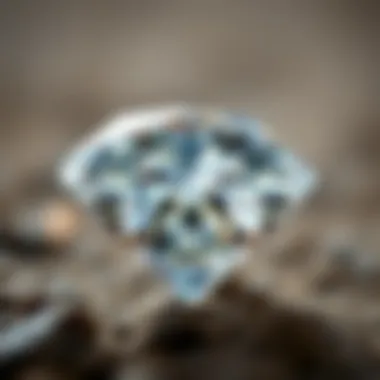
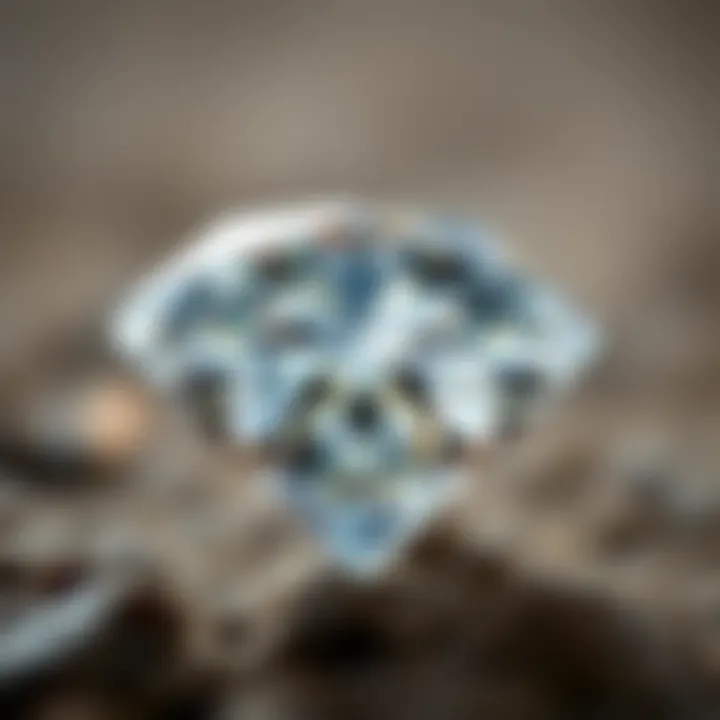
Intro
When one ponders the allure of precious gems, it's impossible to overlook the deep historical roots and intricate stories woven into their existence. Every gem carries with it not just the weight of geologic time but also the hand of humanity, influencing cultures and economies over centuries. The world is dotted with hidden treasures, waiting to be uncovered by keen collectors and enthusiasts.
Gems like diamonds, rubies, and sapphires often steal the spotlight, but equally fascinating are the lesser-known stones that boast unique physical properties and rich narratives. This article aims to peel back the layers—both literal and metaphorical—of these natural wonders.
As we set out on this journey, expect to encounter not just the shimmer and shine of these gems, but also the stories of their origins and the processes that have shaped their characteristics. From the glimmering allure of diamonds to the deep serenity of sapphires, each stone invites us into a saga of geology, artistry, and even spirituality.
Get ready to dive deeper into the multifaceted world of gems, where beauty meets a narrative, and every sparkle holds a story.
Prolusion to Precious Gems
The realm of precious gems has long captivated human imagination, serving not only as symbols of affluence but also as markers of beauty and rarity. In this segment of our exploration, we look into the significance of precious gems within the context of history, culture, and economics. Understanding precious gems helps collectors not only appreciate their visual appeal but also grasp their underlying value, history, and the intricacies behind their formation and classification.
Defining What Constitutes a Precious Gem
Precious gems are typically characterized by their rarity, durability, beauty, and the ability to be polished into lustrous forms. But what really puts a stone into this category? It’s not merely about being expensive; it involves several factors. Most commonly acknowledged are diamonds, sapphires, emeralds, and rubies, each with unique qualities that elevate them above other stones.
- Rarity: Precious gems are rare in nature, which naturally fuels their high market value. A simple diamond may be found in several places, but a vivid blue sapphire, like the one from Kashmir, is considered a treasure due to its scarcity.
- Durability: The ability to resist scratches and degradation over time is crucial. For instance, diamonds possess a hardness level of 10 on the Mohs scale, making them the hardest known minerals. This durability translates to longevity, both physically and in market value.
- Aesthetic Appeal: The sparkle and color of a gemstone are pivotal in its classification. A gemstone like a ruby stands out not just for its hue but the depth of that hue, which can evoke emotions and attract buyers.
- Cultural Significance: Many gemstones carry historical and cultural weight that amplify their perceived value, qualities that resonate with collectors and enthusiasts alike.
The Gemological Perspective
From a gemological standpoint, precious stones are analyzed based on several scientific properties that contribute to their worth. Gemologists utilize tools like microscopes, refractometers, and spectrometers to examine and document these characteristics.
- Color: This is often the first attribute noticed. Gemstones can exhibit different colors influenced by their trace elements. For example, the vibrant red of a ruby comes from chromium, while sapphires can be diverse, from deep blue to even pink, depending on the presence of different minerals.
- Clarity: Clarity refers to the presence of inclusions or blemishes within or on the surface of a gemstone. The fewer the inclusions, the more valuable the gem. Gemological labs grade clarity based on strict criteria, which is essential for appraisals.
- Cut: The way in which a gem is cut impacts its brilliance, sparkle, and overall beauty. A well-cut diamond reflects light in a way that maximizes its sparkle, while poor cuts can detract significantly from a stone's attractiveness.
The unexpected beauty of a gem often reveals secrets of its journey through Earth, forming a narrative uniquely its own.
Understanding these gemological parameters provides a solid foundation for collectors and enthusiasts as they navigate through the world of gemstones. As we proceed through the article, we aim to deepen this understanding further by delving into the specific types of precious gems, their market dynamics, and their importance in various cultures.
The Most Renowned Precious Gems
When one thinks of precious gems, a few names tend to shine brighter than others, capturing both the imagination and acclaim of enthusiasts around the globe. This section examines these celebrated gems in detail, considering their unique properties, cultural significance, and market nuances. Understanding these renowned gems not only enriches the knowledge of collectors and fans but also offers a glimpse into the intricate world of gemology—the art and science behind nature’s stunning masterpieces.
Diamonds: The Pinnacle of Luxury
Formation and Characteristics
Diamonds are often regarded as the apex of luxurious gems. Formed deep within the Earth under extreme heat and pressure, they are composed of carbon atoms arranged in a crystal lattice that grants them their exceptional hardness. The fascinating thing about diamonds is how their formation conditions lead to their stunning clarity, brilliance, and fire—qualities that make them much sought after. The unique feature of diamonds lies in their ability to refract light, creating a spectacular sparkle that is hard to rival.
However, not all diamonds are created equal. Factors like cut, color, clarity, and carat weight—the famous four C's—greatly influence their appeal and price. For collectors, knowing the specifics about these properties allows them to make informed choices.
Cultural Impact
The cultural significance of diamonds runs deep throughout history, often symbolizing eternal love and commitment. Their use in engagement rings has cemented their status as emotional artifacts, cherished for generations. Moreover, diamonds also have become a status symbol in society, often associated with wealth and affluence. However, there are ethical concerns regarding conflict diamonds, which can tarnish their allure. The push for ethically sourced diamonds has been gaining momentum and is an essential consideration in today's market.
Market Dynamics
In terms of market dynamics, diamonds are a complex commodity influenced by various factors including supply chain issues, technological advancements in synthetic alternatives, and shifting consumer preferences. The luxury diamond market can fluctuate significantly depending on global economic conditions. For enthusiasts and investors alike, understanding these dynamics can be crucial to predicting future trends and making wise purchasing decisions.
Rubies: The King of Gems
Color Variations
Rubies, with their blood-red hue, have often been crowned as the king of gems. But what many may not realize is that rubies can exhibit a spectrum of color variations including pink and purplish shades. The specific hue and saturation of red can dictate a ruby’s value, with pigeon blood red being the most coveted. For collectors, this breadth of color boosts both the market diversity and personal choices in their acquisitions of this prized stone.
Historical Significance
Historically, rubies have held a unique position in various cultures, often viewed as symbols of power and passion. Ancient warriors believed rubies could give them invincibility or protect against their enemies. This aura of historical significance deepens for many collectors, making rubies not just gems but also stories woven into the fabric of human history.
Collecting Rubies
In collecting, rubies present a fascinating landscape. Their rarity and the allure associated with their vibrant colors often draw attentions from passionate collectors and investors. However, the market can be competitive and requires discerning eyes to spot high-quality stones among the more common ones. Building a collection of rubies runs the risk of encountering untreated stones mixed with treated ones, which could greatly affect value. A steady hand and a bit of patience can go a long way in this thrilling pursuit.
Sapphires: Beyond Blue
Different Colors
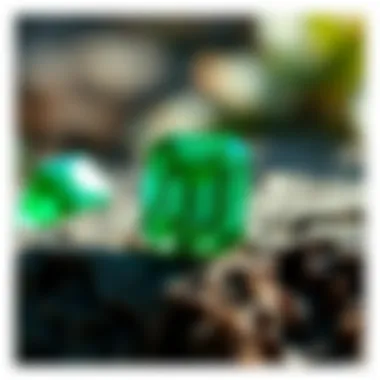
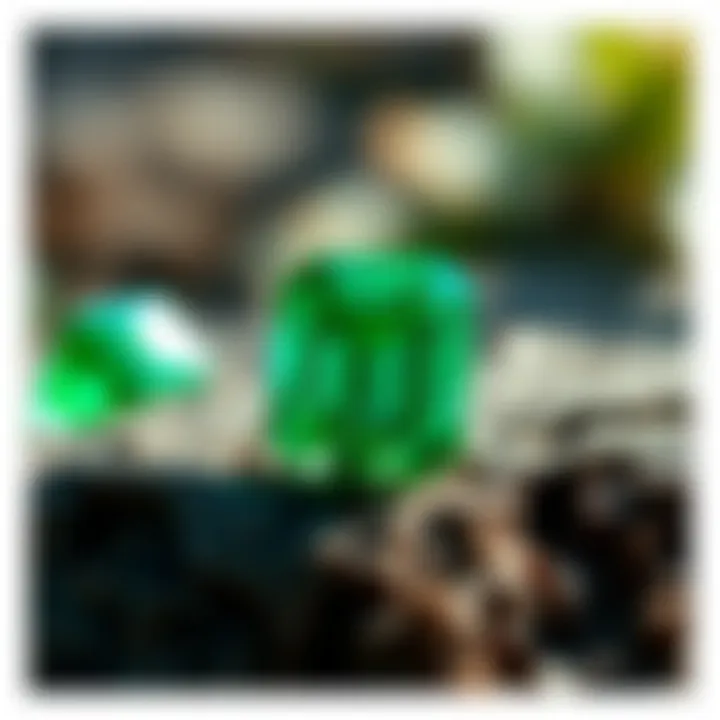
While blue sapphires are often the first to come to mind, these gems can also be found in a variety of colors, from yellow to pink and even green. Each color presents its own aesthetic charm and potential collector's interest. Each variety possesses unique characteristics that can impact its desirability in the market. This versatility not only increases a sapphire's market presence but offers collectors a broader canvas of choices to explore.
Historical Associations
Sapphires have been linked to royalty and religious significance through various cultures, often believed to protect their wearers from harm while promoting wisdom and nobility. Given their rich historical backdrop, sapphires are more than just beautiful stones—they are living relics that connect people to centuries past.
Investment Value
From an investment standpoint, sapphires present diverse opportunities as their value tends to appreciate over time, especially for rare colors and qualities. It is important for collectors to monitor market trends, as the allure of colored sapphires continues to grow. Understanding market demand aids in making informed investment decisions, ensuring the gems not only capture aesthetic appreciation but also financial growth.
Emeralds: Timeless Green
Source Locations
Emeralds are known for their lush green color, but did you know their origin impacts their value? Major sources like Colombia, Zambia, and Brazil each produce varying qualities and shades of emeralds. Colombian emeralds, renowned for their vibrant hues, often fetch the highest prices. Knowing these source locations is invaluable for any collector seeking to invest in emeralds; it directly ties into the reputation and potential worth of individual stones.
Value Assessment
Value assessment of emeralds involves a keen understanding of their unique inclusion patterns, often called 'jardin.' This can make evaluating authenticity more intricate. While inclusions might detract from the value of other gems, they may actually add character to emeralds. For collectors, this makes each emerald a distinct piece to fully understand and appreciate.
Care and Maintenance
Despite their enchanting beauty, emeralds require careful handling. The porous nature of emeralds can make them vulnerable to damage from chemicals and oils. Regular cleaning and mindful storage are paramount in maintaining their allure. Collectors should always be mindful of how they showcase their emeralds—some envelop them in settings that keep them secure while allowing light to interact beautifully with the gem.
"Understanding the world of precious gems is a journey filled with beauty, passion, and commitment. Each gem tells its own story, rich with history and significance."
For anyone passionate about rocky treasures, the world of precious gems offers an endless exploration of aesthetics and values to unearth.
Rare and Unique Gems
The fascination with rare and unique gems goes far beyond their visual appeal. These gems carry stories that are often intertwined with the history of mankind, the earth’s geology, and the artistry of human craft. Their rarity usually means they come from limited sources, giving them a sense of exclusivity that many collectors desire. Understanding these gems not only enhances appreciation but also brings valuable insights into their investment potential and the nuances of their market trends.
Among the myriad gems, some stand out for their distinctiveness and unique charm. Collectors often find themselves drawn to gems that tell a story or hold a significant cultural value. The quest for rare gems can often feel like a treasure hunt, where the thrill lies as much in the journey as in the destination.
Tanzanite: A One-Location Wonder
Discovery and Mining
The discovery of Tanzanite in 1967 near Mount Kilimanjaro in Tanzania remains an adventurous tale in the gem world. A helping hand from local Maasai pastoralists led to the unearthing of this vibrant, blue-violet stone. The mining operations happen only in this singular location, making it a truly unique find.
This locality restriction means that anyone wanting to own a Tanzanite gemstone is looking at a piece of geological history that could one day be mined out entirely. The uncertainty surrounding its dwindling supply adds to its allure, making it a valuable conversation piece besides being beautiful.
Gem Characteristics
Tanzanite is well-known for its captivating color, which can shift from blue to purple depending on the angle of light. The gem’s pleochroism is a significant characteristic, allowing it to display multiple colors in just one stone. This uniqueness lends Tanzanite an advantage in the luxury market, appealing to those seeking stones that stand out.
However, its delicate nature means that owners need to be cautious in terms of care and usage. Tanzanite is softer than many other gemstones, scoring between 6 and 7 on the Mohs hardness scale, which might limit some typical wear conditions.
Collecting Tips
For collectors, Tanzanite represents a blend of rarity and aesthetic appeal, but it also invites specific considerations when building a collection. Understanding the color saturation, clarity, and gemstone cut is essential for distinguishing high-quality pieces from less desirable options. Moreover, purchasing from reputable jewelers ensures that you receive quality stones.
It’s wise for collectors to keep an eye on market trends as well, since the value could fluctuate quite a lot due to mining conditions, the global market, and public interest. A well-curated collection can easily turn into an impressive asset if attended to right.
Alexandrite: Color-Changing Marvel
Properties and Rarity
Alexandrite's remarkable ability to shift colors, from green in daylight to reddish-purple in incandescent light, makes it an extraordinary gem to own. This optical marvel is a result of its unique composition, primarily made from Chrysoberyl, a mineral celebrated for its strong pleochroism—revealing different shades when viewed from various angles.
Due to its limited deposits, primarily found in Russia, Brazil, and Sri Lanka, it's one of the rarer gemstones in circulation. Collectors find this rarity appealing, but prices can skyrocket due to the demand, especially for stones with vivid color changes. Thus, Alexandrite is not just a pretty stone; it’s a valuable investment.
Famous Finds
Throughout history, certain Alexandrite stones have achieved iconic status, attracting the attention of gemologists and collectors alike. One notable example is the "Imperial Alexandrite" discovered in the 19th century, which has become synonymous with luxury and elegance. Such finds often come with fascinating stories, increasing their desirability among collectors.
However, its fame can also reflect on the pricing, which may not suit all budgets, thus narrowing the pool of potential owners.
Market Trends
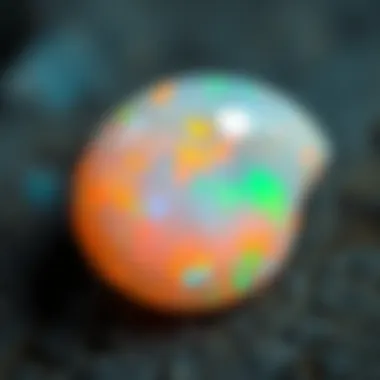
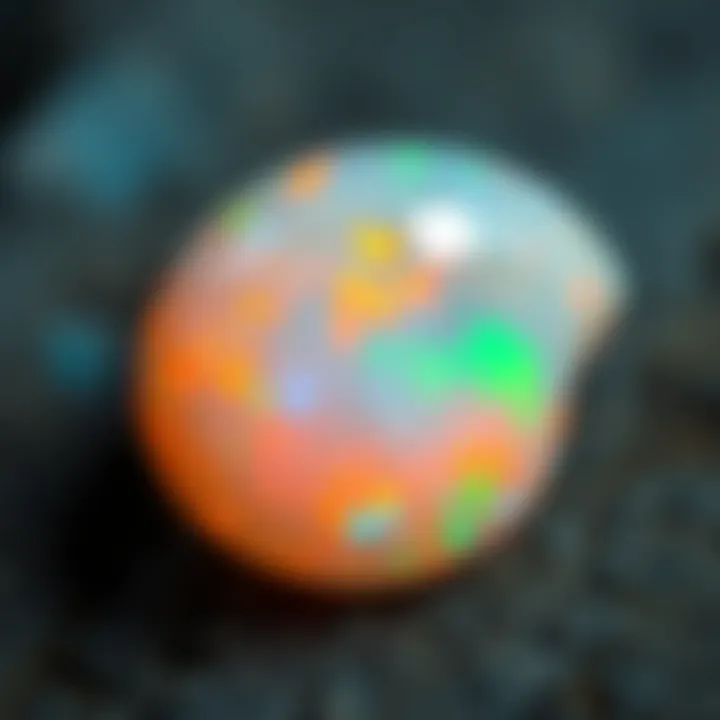
Alexandrite's market is influenced by both aesthetic qualities and rarity, establishing it as a favorite amongst advanced collectors. Prices can vary significantly based on size, color change, and clarity, so individuals need to stay informed about recent duplicates and trends to prevent overpaying or purchasing imitations. Collectors should become familiar with sources and experts within the field to gain insights into where the market is heading.
Opal: Nature’s Color Palette
Types of Opals
Opals exhibit a spectrum of colors, with varieties like black opal, white opal, and boulder opal each holding distinct qualities. The vibrant flashes of color seen in opals stem from the arrangement of silica spheres within the stone, which creates a play-of-color phenomenon. This complexity makes opals both appealing and challenging to appreciate.
Black opals, for instance, tend to be the most sought after due to their rarity and striking contrast against their darker background. While the variety in types offers something for many tastes, it can lead to confusion for novice collectors.
Cultural Significance
In many cultures around the world, opals are treasured for various reasons. They are often seen as symbols of hope, innocence, and purity. In ancient Rome, they were thought to hold the power of foresight; some cultures believed opals could ward off evil. Individual histories behind different opal types can create a robust narrative for collectors, enhancing their desirability.
However, its cultural associations can also lead to superstitions viewed unfavorably in certain communities, which may hinder purchases for those individuals.
Maintenance Guidelines
Caring for opals requires extra attention. Their structure makes them hydrophilic, meaning they can absorb water and become cloudy over time. A simple cleaning with mild soap and warm water is advisable, steering clear of harsh chemicals that could harm the stone.
Also, given the moisture factor, storing opals away from direct sunlight and maintaining humidity can prevent damage, which might seem cumbersome but is essential for preserving their stunning appearance.
The more a collector knows about the nuances of each gem, the better they can navigate the enticing yet intricate world of rare and unique gems.
The Science Behind Gems
Understanding the science behind gems enriches our appreciation of these natural marvels. Knowing the elements that compose various gemstones and the processes through which they are formed not only enhances the collector's knowledge but also aids in valuing and caring for these treasures. Moreover, the complexities involved in gemology pave the way for informed investments and responsible collecting practices.
Mineral Composition and Structure
Every gemstone has its unique mineral makeup, dictating its physical attributes. For instance, diamonds are a crystalline form of carbon, showcasing remarkable hardness and brilliance due to their tightly packed structure. On the other hand, emeralds, composed mainly of beryllium aluminum silicate, exhibit a characteristic green hue from trace elements of chromium or vanadium. This stark difference impacts not only aesthetics but also durability and wearability.
The structure of a gem can reveal its origins and authenticity. Characteristics like cleavage, fracture patterns, and birefringence help gemologists identify specific stones. For example, a gem with distinct cleavage planes may indicate it was formed under different pressure conditions compared to another that appears homogenous. This intricate web of mineral properties showcases how diverse and complex these earthly treasures can be.
Geological Formation Processes
The journey of a gem starts deep within the earth, often in extreme conditions that are hard to imagine. For instance, diamonds are formed approximately 100 miles below the Earth's surface, where heat and pressure crystallize carbon. This geological process can take billions of years, making them not only rare but highly valued.
Conversely, sapphires form near volcanic environments where magma cools. The addition of iron and titanium during this cooling process contributes to their stunning range of colors. Understanding these formation processes is crucial for collectors; it directly influences the rarity and valuation of gems. By recognizing the geological history behind gems, collectors can better understand their significance and the narratives they hold.
In summary, grasping the science behind gems enhances our appreciation for their beauty. It illustrates the meticulous journey from mineral composition to geological processes, laying a foundation for informed collecting and investment choices.
"Gems are not merely commodities; they embody earth's history and the natural world's artistry."
For further reading on gem science and mineral composition, consider visiting:
Engaging with these resources can provide a deeper insight into the complexity of precious gems, enhancing both personal collections and general knowledge of these remarkable geological formations.
Market Trends and Valuation
Understanding market trends and valuation is vital in the world of precious gems. Knowledge of these trends not only helps collectors make informed purchases but it also allows investors to gauge potential opportunities in a fluctuating market. The value of precious gems can be as fickle as the wind; they are influenced by various internal and external factors. By analyzing these nuances, individuals can navigate the marketplace effectively.
Factors Influencing Gem Prices
Rarity and Demand
Rarity and demand are two sides of the same coin that deeply affect the pricing of gems. When a certain gemstone is rare, it often commands a higher price tag due to its limited availability. This scarcity is a key characteristic of gems like the red diamond or the black opal. Since these particular stones aren't just found around every corner, collectors are willing to shell out more for them. However, this rarity doesn’t exempt them from market fluctuations. Demand can ebb and flow based on trends, affecting overall price stability.
Moreover, the unique aspect of rarity is that it not only elevates the gem's status but can also limit the opportunities for collectors. For example, acquiring a rare gem may require a hefty investment or specialized connections. This highlights the dichotomy between the allure of rarity and the potential barriers it poses.
Quality Grading
Quality grading of gems is another cornerstone of their valuation. Established grading systems, such as the Gemological Institute of America (GIA) scale, focus on the characteristics of cut, color, clarity, and carat weight. Each gem's quality can considerably dictate its market value. High-quality stones are usually rated higher, bringing with them an expectation of higher prices.
What sets quality grading apart is its specificity. It provides a benchmark against which potential buyers can measure their investments. A drawback, though, is the potential for subjective interpretations. Different experts might assess a gem's quality differently, leading to inconsistencies in pricing. Collectors need to be aware of this to make well-informed decisions.
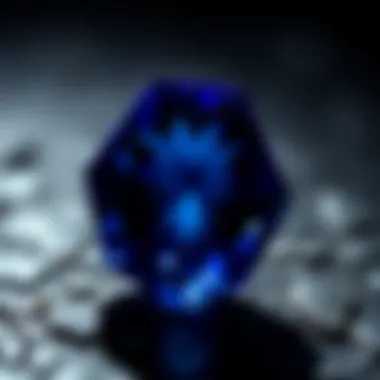

Cultural Trends
Cultural trends, while more abstract, can significantly shape the market for gems. As aspects of culture evolve, so do the demands for certain stones. For example, in recent years, the rising interest in ethically sourced gems revealed a shift in consumer preference. This trend boosts the value of gems that are certified as conflict-free.
What makes cultural trends particularly compelling is their ability to create burgeoning markets overnight. For instance, the increasing popularity of colored diamonds has shifted focus away from traditional white diamonds, making previously less sought-after colors more desirable. But, there are caveats. Cultural trends can be fleeting; what’s hot today might not be in a few years. This volatility can affect long-term investments in certain gems.
Investment Opportunities
In an increasingly diverse marketplace, investment opportunities abound. The potential to earn returns on precious gems lies not just in their aesthetic appeal but also in their intrinsic properties. While some gems might offer short-term flips, others—especially those backed by rarity and cultural significance—might promise more substantial, long-term gains. Understanding market trends can be the key to turning a mere collection into a lucrative investment over time.
Caring for Precious Gems
Caring for precious gems is an essential aspect that often gets overshadowed by the shine and beauty these stones exhibit. Proper care not only preserves the intrinsic value of gemstones but also enhances their beauty over time. When you invest in gems, you're not just buying a piece of nature's artistry; you're also acquiring a potential heirloom that can be passed down through generations. Understanding how to maintain these treasures can enhance their allure, avoid damage, and ultimately protect your investment.
Cleaning and Maintenance Techniques
Keeping your precious gems clean is paramount. Dust, oils from the skin, and environmental pollutants can cloud their brilliance. Here are some techniques and tips:
- Gentle Cleaning: Use a soft brush, like a toothbrush with soft bristles, to gently scrub the gem. For deeper cleaning, a mix of warm water and mild dish soap can work wonders. Soak the pieces for a few minutes before rinsing them under warm running water. Avoid harsh chemicals, as they can damage certain stones.
- Ultrasonic Cleaners: For more thorough cleaning, consider investing in an ultrasonic cleaner, but be cautious. While many gemstones can withstand this method, certain stones like pearls, opals, or any that are treated might not fare well.
- Professional Help: When in doubt, especially for high-value items, seek a professional gemologist. They have the equipment and expertise to ensure your gems are cleaned appropriately without risking damage.
- Regular Checks: Periodically check for any loose settings or damage. Early detection of issues can save you from costly repairs down the line.
"Keeping your gems in their prime requires more than just a dusting; it’s about establishing a routine that considers their specific needs."
Storing and Displaying Gems
Once your gems are clean, how you store and display them plays a critical role in their longevity and beauty. Here are a few options:
- Safe Storage: Store each gem in a soft pouch or a separate compartment in a jewelry box. Avoid placing gems together as they can scratch each other. Hard stones can damage softer ones; for instance, storing diamonds with opals can lead to unwanted scratches on opals.
- Secure Environment: Keep gems in a cool, dry place to avoid deterioration. Humidity and extreme temperatures can negatively affect certain gemstones. A desiccant can be beneficial if humidity is a concern in your area.
- Display with Care: If displaying gems, ensure they are kept away from direct sunlight. Too much exposure can fade the colors of certain stones.
- Avoid Daily Wear: Not all gems are suitable for daily wear. Stone like emeralds can be more prone to chipping due to their natural inclusions. Consider rotating your jewelry to prevent wear and tear.
By being diligent in the care and storage of your precious gems, you aren’t just maintaining their aesthetic appeal; you’re also safeguarding your investment. With mindful practices, these natural treasures can continue to sparkle brightly for ages to come.
For further details on gemstone care, resources like the Gemological Institute of America and National Jeweler provide in-depth insights on maintenance and valuation.
Collecting Gems: An Enthusiast’s Guide
Collecting gemstones is more than just a hobby; it’s a passion that connects enthusiasts to nature's artistry and the intricate histories behind each gem. This subheading will explore various aspects of gem collection, from understanding what to look for in a quality gem to how to effectively curate and manage a collection. Collecting gems can serve various purposes—from aesthetic appreciation to potential investment—making it a richly rewarding pursuit.
Starting a Collection
Starting a gem collection can feel like a daunting endeavor, yet it is fundamentally about personal passion and curiosity. Here are some fundamental elements to consider:
- Know Your Interests: Determine what draws you to gems. Is it the vibrant colors of sapphires? The rarity of diamonds? Or perhaps the historical significance of emeralds?
- Research: Knowledge is power. The more you learn about gemology, the better equipped you are to make wise purchasing decisions. Resources like the International Gem Society (https://www.gemsociety.org) offer excellent guides on identifying and valuing gems.
- Start Small: Rather than going all in for an expensive gemstone right off the bat, begin with more affordable options to build your confidence and experience. You could start with quartz or agate, for example, which are plentiful and can be very beautiful.
- Quality Over Quantity: It’s tempting to amass a large collection quickly, but focusing on acquiring a few high-quality pieces is far more beneficial in the long run. Pay attention to the clarity, cut, color, and carat weight of each gem.
- Documentation: Keep detailed records of your gems, including their origin, purchasing date, and any assessment certificates. This information can aid in future sales and offers a way to trace your collection’s history.
In starting your journey, it's crucial to hold onto the genuine joy that comes from discovering each stone. Remember, each gem you collect tells a story.
Networking and Community
The world of gem collecting is not just about individual exploration; it's also about community. Connecting with other enthusiasts can lead to opportunities you might not find independently. Here’s how to get involved:
- Join Clubs and Organizations: Many areas have gem and mineral clubs where members can share resources, organize mining outings, and attend gem shows. The American Gem Society (https://www.americangemsociety.org) is a great place to start.
- Online Forums and Social Media: Platforms like Reddit and Facebook host communities dedicated to gem collecting. These spaces enable you to share experiences, ask questions, and even trade gems with others.
- Attend Gem Shows: Visiting gem shows can be exhilarating. These shows provide opportunities to see a wide range of gems, learn from experts, and meet other collectors. Some popular events include the Tucson Gem and Mineral Show and the Denver Gem and Mineral Show.
- Showcase Your Collection: Whether through social media or local exhibitions, displaying your collection fosters connections. Sharing your passion can inspire others and might also attract potential buyers should you ever consider selling.
Collecting gems is an immersive experience that not only fills your shelves—but also fills your spirit. Embrace the journey and welcome others along for the ride.
Culmination
Whether you are an avid collector or simply an admirer of nature's artistry, the allure of precious gems cannot be overstated. This article has taken you through a detailed journey exploring the multifaceted characteristics of these remarkable stones, from the pinnacle of luxury in diamonds to the unique charm of rare finds like tanzanite and alexandrite. Each gem exhibits distinct properties that resonate with both collectors and casual enthusiasts alike, making them objects of great fascination and desire.
The review of gems such as rubies, sapphires, and emeralds highlights their rich histories and the cultural significance they hold across various civilizations. Beyond their beauty, the ongoing trends in the market, and the nuanced methods of valuation discussed, emphasize the need for a well-rounded understanding when approaching gem collection. Factors like rarity, quality, and even cultural trends play pivotal roles in shaping their perceived worth.
Additionally, caring for these treasures is paramount to preserving their brilliance and value. Techniques for cleaning, storage, and proper handling ensure that gems maintain their original luster for generations to come. For collectors, engaging with the community and sharing knowledge can amplify enjoyment and foster deeper appreciation for these natural marvels.
The everlasting allure of gems lies not just in their physical attributes, but also in the stories they tell and the emotions they evoke. Collecting is not merely about assembly; it’s about creating a narrative that connects the past, present, and future. As you reflect on the information presented, remember that the journey of discovering, acquiring, and cherishing precious gems is an adventure filled with both knowledge and joy.
"A gem is not polished without rubbing, nor a man perfected without trials." - Chinese Proverb
In summary, the discussions in this article underscore the significant impact that precious gems have on culture, investment, and personal sentiment, revealing a world where beauty and value intersect in the most captivating ways.
The Everlasting Allure of Gems
The enduring appeal of gems can be attributed to several factors. Firstly, their beauty is undeniable. The vibrant hues and intricate patterns create an aesthetic appeal that can captivate anyone. Gems like sapphires and emeralds not only shine bright but also carry a depth of color that resonates with personal taste and societal values.
Secondly, many gems are steeped in rich histories and mythologies. For instance, the ruby has long been regarded as a symbol of love and passion, while emeralds have been associated with fertility and rebirth. These narratives enhance the emotional connection individuals have with their stones, turning each piece into not just a decoration, but a talisman of personal significance.
Lastly, there is a certain thrill in collecting gems that transcends mere ownership. The search for the rarest stones or the perfect cut can fuel a passion that lasts a lifetime. Dedicated collectors often find themselves part of a global community, sharing insights and experiences that enrich the pursuit.
In exploring the everlasting allure of gems, it becomes evident that they are more than just pretty stones; they are embodiments of culture, history, and personal stories. They remind us of the beauty of nature's creation and the deep-seated human emotions tied to such profound treasures.



